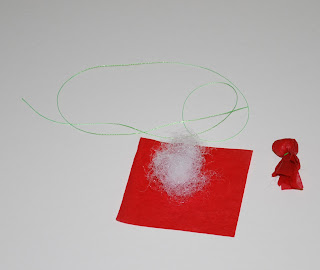This set of instructions was a primer for what the Victorian housewife was intended to do to create realistic paper flowers. After practicing with patterns she was to go on and dissect real flowers using those as a guide to her own creative endeavours.
A Mrs Delaney, who lived sometime in the late 1700's was so known for her abilities with the recreation in paper of real flowers, that the King and Queen sent new floral discoveries to her first, so she could immortalize them in paper. Unfortunately, this photo is in black and white, but the intricacy can still be appreciated.
So let's get started.
Get the directions and template here.
These are the shapes. I cut them out and numbered them with the number of petals required of each. If you do them out of tissue, just cut lots.
Here's the little ball.
There the petals are crimped.
and grouped ready to go.
Make the next set of petals curve. I used the end of my awl on a mouse pad. The shaft of the awl comes in handy later for the last set of petals to help create the reverse curl.
So here's where I think I messed up. After getting to the end, I am pretty sure that the balls belong on the inside of the rose and maybe those petal should also go the other way, bending towards the centre. See why you need to be looking at the real thing.
The last set of crimped petals go in between the others, again refer to my comments on the last step.
So here go the out petals. I am pretty sure that they are going on the right way. If you were a Victorian lady doing this, it would be about the time in the afternoon that you would be expecting your tea to be served and you would be wondering where your housemaid was. You'd wander into the yard to find her collapsed under your 100 pound oriental rug that she had to drag outside to beat the dirt out of, a job she naturally does every Wednesday.
I added a little tab for gluing, because just looking at the bottom of this rose, I knew it wouldn't work otherwise.
Voila, you think, one done! The maid had better get up before the neighbours see her and think you allow her to nap midday in the yard.
Have fun and happy crafting!













